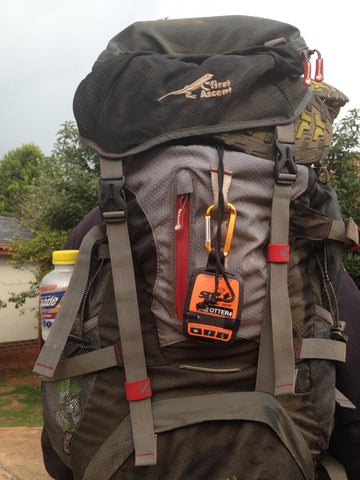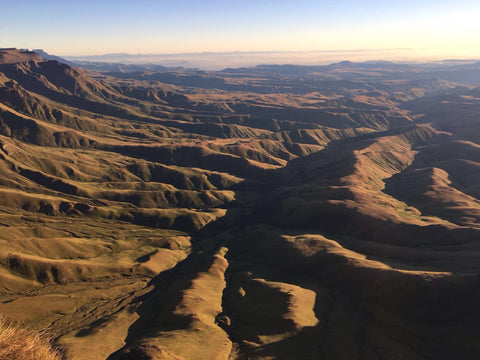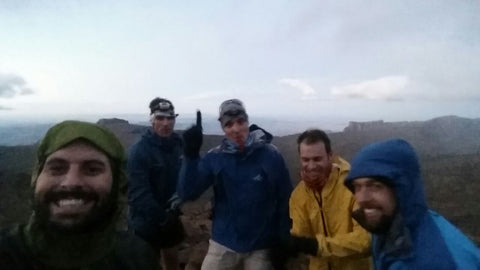#DGT2016 - 4am and the bloody alarm is telling us that it’s time to get up; we have been awake all night anyway…

It was at least two years ago that I had this idea that doing a Grand Traverse of the entire Drakensberg (here forth known as the DGT) would be fun. After some research, I had planned on doing it in ten days.
It was just before Ryno Griesel and Ryan Sandes did their FKT (Fastest Known Time) of the DGT. Ryno said that he would be attempting a sub 45hr traverse and they proceeded to do it in just under 42hrs! Then, after chatting to Cobus Van Zyl (their maps and planning guy), I thought maybe 10 days was too long and doing it in 4 or 5 was a better idea.
So began my decent into madness…
In the end 5 of us signed up, and I had my team. It consisted of: Martin, Douglas, Marc, Kevin and myself. Together we sat and planned the distances and camp sites, Martin and Kevin are engineers and they had worked it all out on a spreadsheet, I was/am quite impressed. On paper, we were ready…
I figured that in order to do something like this I would need to be fit, so I upped my running (mostly on trails in and around Johannesburg), bought new road running shoes, and got some PB’s on Strava at the time trials. I was ready for this!

Except… I wasn’t.
We left on Thursday morning and drove down to the Sentinal car park and due to a series of unfortunate events, only started hiking at 15h20. We made really good time and summited Mont-Aux-Sources, our first peak, quite quickly. We were about half way up when I started getting a dull head ache. I thought that it was the cold and didn’t take much notice of it really. We wanted to push as far as we could on that first night as we were strong and fresh, so we got to about the 14km mark and set up camp.
I had this [innovative] idea to combine couscous, cuppa snack, and a sachet of tuna to make a quick easy meal; here in lay one of many lessons that I was about to learn: try EVERYTHING before you leave! On the mountain it became like a soggy, salty cake and as my head ache had invited its friend nausea to the party, there was little I could do to force the food into me.
We heard two packs of dogs barking the whole night and in the still quiet of the Berg it sounded like they were right next to us. Every time we heard any sound we were convinced that we were going to have our faces eaten off. Finally, 4:30 came around and we started breakfast and packing up. By 5:30 we were mile munching; we needed to do about 40km and it was tough going. Valley after valley came up and we would try contour around them where possible, but we were following Ryno and Ryan’s tracks and somehow in my mind I imagined that they would have taken the easiest, fastest and shortest path. I have since changed my mind about the easiest part.
The guys were looking really strong and were covering a lot of ground really fast, and at this point I was feeling drained and lacking energy. I put it down to the fact that we were 3000+ meters above sea level and that I had a giant pack on my back and we were walking over ground that seemed determined to break our ankles. I obviously wasn’t all there as at one point I looked down at my arm and noticed that my beloved Suunto Ambit was gone!!! I panicked, and Douglas and I went back to see if we could find it. The mountain is a big place and there was very little chance of us actually working out where it was, it was gone… that really hit me and took the little wind that was left in my sails, out.
The nausea was back, this time it had made buddies with another guy named, fatigue. So now I was carrying three monsters and they were quite unpleasant.
Eventually we reached a “levelish” site by a river and we set up camp, I was broken. I climbed into my sleeping bag and started to shiver uncontrollably. The guys told me to eat. This time I had a backcountry dehydrated meal and although it was sweet and sour lamb, I just couldn’t get it in.
The wind was clocking in at 50-80km per hour and the tent was taking some strain, it was super loud and sleep was again a distant thought.
4am and the bloody alarm is telling us that it is time to get up, we have been awake all night anyway. This morning I wasn’t feeling like myself. I had thought that I could sleep it off and would be ok in the morning, but it was morning and I was feeling worse.
I called a team meeting and told the guys that I wasn’t going to make it. “This is exactly what I signed up for, but it’s not what I trained for” I told the guys. I could think of two options, either I go down alone or if someone would join me, then we could try make it to Giants Castle.
Kevin offered to join me in a shot for Giants and we all swapped food, equipment, and tents. At 4:30am, I gave the SPOT GEN3 tracker to Marc and showed him how to use it. With gale-force winds and no sleep, I doubt he remembered much because he didn’t start the tracking, which caused a bit of concern with our support crew.
The others set off to complete the adventure, and immediately I regretted my choice, but there was no way I was going to catch them now. Once the sun rose, Kevin and I set off and slowly made our way to Cleft Peak. I was exhausted and couldn’t keep any food or drink down. I had the GPS and used that to distract me.
We climbed the elephant and sat at the foot of Cleft and I looked up and knew that I was done. If I wasn’t going to be able to summit the peaks then what was the point? I couldn’t keep any food or drink in and I felt like a car running on empty.
This was the lowest point for me in a long time. I had set out with some mates to have an adventure and now I was bailing out and we were only quarter of the way. I have a habit of taking on challenges and then not being able to finish them and I hate that about myself. Someone once said that, “at least you try”, but I don’t think that’s good enough, I really want to complete what I start. All this running through my mind should have stirred me to get up and keep going but I had nothing left. I saw that we were close to Tseketseke pass and I knew that there was a hut at the bottom and then a hotel. I asked Kevin if we could bail and he agreed.
We headed down and arrived at the hut. I went to sleep and 12 hours later I woke up, attempted breakfast, and it stayed in! We had coffee, packed, and headed to the hotel. I popped a pain killer that I bought when I was in Egypt and about 30min later I mentioned to Kevin that I didn’t feel normal, I was high as a kite! At least I wasn’t in pain though. In hind sight, I should have handed navigation over to Kevin because 2km later and we hadn’t found the path out of the valley of boulders. Turning around, we saw it, and had to hike back up to get onto it.
Eventually we got to the hotel and I told Kevin to try look “normal”. As soon as we stepped through the doors a little boy saw me and asked, “Are you ok?” I said, “yeah, fine, nothing wrong here”, and shortly afterwards I realised how bad I must have looked when one of the hotel guests came and offered us an assortment of fruit and biscuits!
Marc’s family was amazing! They took us to their beautiful guest house in Underburg and treated us like family. I climbed into a warm soft bed with an electric blanket and slept.
The next morning, I heard from the other team: they had just summited Giants and Marc wasn’t doing well, he was struggling to breathe and had twisted both ankles… they were coming down.

We picked them up and took them back to Marc’s parents’ house for a beer and braai. Sitting around the braai we laughed and chatted about our experiences. Turns out, this is the part I love about hiking.
We learnt a lot: fitness is good but you need strength too if you want to do this hike; The only way to train for this hike is to hike in the Berg; Find and test food that works for you; Altitude is nasty and will hurt you if you aren’t careful.
However, we also got a lot right! We planned everything really well; we had an amazing support team they were constantly checking in on us and sending messages; and the SPOT GEN3 tracker made a huge difference from a safety and peace of mind point of view.
I couldn’t have asked for a better team to join me. They are an amazing bunch of guys and I look forward to trying this with them again soon (but not too soon)!














